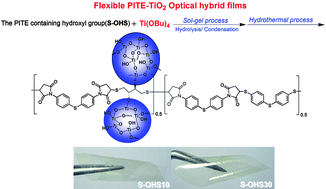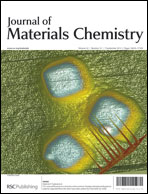In this study, a new facile synthetic route was developed to prepare polyimidothioethers–nanocrystalline-titania (PITEs–TiO2) hybrid optical films with a high titania content (up to 50 wt%) and thickness (15 ± 3 μm) from soluble PITEs containing hydroxyl groups. A series of organosoluble PITEs were prepared from the hydroxy-substituted dithiols and various commercial bismaleimides via Michael polyaddition. The hydroxyl groups at the backbone of the PITEs could provide the organic–inorganic bonding sites and resulted in homogeneous hybrid solutions by controlling the mole ratio of titanium butoxide/hydroxyl group. AFM, TEM, and XRD results indicated the formation of well-dispersed nanocrystalline-titania. The flexible hybrid films were successfully obtained and revealed good surface planarity, thermal dimensional stability, tunable refractive index (1.69 to 1.80 at 633 nm), and high optical transparency. A three-layer antireflection coating based on the hybrid films was prepared and showed a reflectance of less than 0.5% in the visible range, indicating its potential optical applications.

You have access to this article
 Please wait while we load your content...
Something went wrong. Try again?
Please wait while we load your content...
Something went wrong. Try again?


 Please wait while we load your content...
Please wait while we load your content...